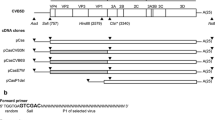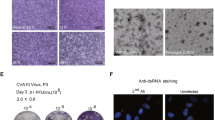Summary
The genome of the non-cardiovirulent coxsackievirus B3 (CVB3) strain CVB3/0 was cloned and sequenced to aid in the elucidation of the viral genetic basis for the CVB3 cardiovirulent phenotype. Reverse-transcribed sub-genomic complementary DNA (cDNA) fragments were enzymatically amplified using generic oligonucleotide primers and were assembled as a complete infectious genomic copy (pCVB3-0) downstream of the T7 RNA polymerase promoter. Positive-strand viral RNA transcribed from pCVB3-0 using T7 RNA polymerase and transfected into HeLa cells produced infectious virus (CVB3/0c). No differences in phenotype were observed comparing growth of CVB3/0c to the parental CVB3/0 in HeLa single-step growth curves, virus yields, or plaque size. When inoculated into C3H/HeJ mice. CVB3/0c achieved cardiac titers equivalent to the parental CVB3/0 and like the parental virus, demonstrated a non-cardiovirulent phenotype. The nucleotide sequence of the cloned CVB3/0 genome was determined and compared to the genomes of infectious cDNA clones of cardiovirulent CVB3 strains. Two consistent differences among nucleotides in non-translated regions and 8 amino acid differences relative to two well-characterized infectious cDNA copies of genomes from cardiovirulent CVB3 strains were identified.
Similar content being viewed by others
References
Agol VI (1991) The 5'-untranslated region of picornaviral genomes. Adv Virus Res 40: 103–180
Almond JW (1987) The attenuation of poliovirus neurovirulence. Annu Rev Microbiol 41: 153–180
Beck MA, Tracy SM (1989) Murine cell-mediated immune response recognizes an enterovirus group-specific antigen(s). J Virol 63: 4148–4156
Bienz K, Egger D, Pfister T, Troxler M (1992) Structural and functional characterization of the poliovirus replication complex. J Virol 66: 2740–2747
Burch GJ, Sun S-H, Chu K-C, Sohal RS, Colcolough HL (1968) Interstitial and coxsackievirus B myocarditis in infants and children. JAMA 203: 55–62
Cherry JD (1987) Enteroviruses: polioviruses (poliomyelitis), coxsackieviruses, echoviruses, and enteroviruses. In: Feigin RD, Cherry JD (eds) Textbook of pediatric infectious diseases. Saunders, Philadelphia, pp. 1729–1790
del Angel RM, Papavassiliou AG, Fernandez-Tomas C, Silverstein SJ, Racaniello VR (1989) Cell proteins bind to multiple sites within the 5' untranslated region. Proc Natl Acad Sci USA 86: 8299–8303
Duke GM, Osorio JE, Palmenberg AC (1990) Attenuation of Mengo virus through genetic engineering of the 5' noncoding poly (C) tract. Nature 343: 474–476
Etchison D, Milburn SC, Edery I, Sonenberg N, Hershey JWB (1982) Inhibition of HeLa cell protein synthesis following poliovirus infection correlates with the proteolysis of a 220 000-dalton polypeptide associated with eucaryotic initiation factor 3 and a cap binding protein complex. J Biol Chem 257: 14806–14810
Gauntt CJ, Godeny EK, Lutton CW, Arizpe HM, Chapman NM, Tracy SM, Revtyak GE, Valente AJ, Rozek MM (1989) Mechanism(s) of coxsackievirus-induced acute myocarditis in the mouse In: de la Maza LM, Peterson EM (eds) Medical virology 8. Plenum, New York, pp 161–182
Gauntt CJ, Trousdale MD, LaBadie DRL, Paque RE, Nealon T (1979) Properties of coxsackievirus B3 variants which are amyocarditic or myocarditic for mice. J Med Virol 3: 207–220
Gauntt CJ, Trousdale MD, Lee JC, Paque RE (1983) Preliminary characterization of coxsackievirus B3 temperature-sensitive mutants. J Virol 45: 1037–1047
Filman DJ, Syed R, Chow M, Macadam AJ, Minor PD, Hogle JM (1989) Structural factors that control conformational transitions and serotype specificity in type 3 poliovirus. EMBO J 8: 1567–1579
Hogle JM, Chow M, Filman JD (1985) The three-dimensional structure of poliovirus at 2.9 A resolution. Science 229: 1358–1365
Innis M, Gelfand D (1990) Optimization of PCRs. In: Innis M, Gelfand D, Sninsky J, White T (eds) PCR protocols. Academic Press, San Diego, pp 3–12
Jacobson SJ, Konings DAM, Sarnow P (1993) Biochemcial and genetic evidence for a pseudoknot structure at the 3' terminus of the poliovirus RNA genome and its role in viral RNA amplification. J Virol 67: 2961–2971
Klump WM, Bergmann I, Muller BC, Ameis D, Kandolf R (1990) Complete nucleotide sequence of infectious coxsackievirus B3 cDNA: two initial 5' uridine residues are regained during plus-strand RNA synthesis. J Virol 64: 1573–1583
Krawczak M, Reiss J, Schmidtke J, Roesler U (1989) Polymerase chain reaction replication errors and reliability of gene diagnosis. Nucleic Acids Res 17: 2197–2201
Kuhn RJ, Wimmer E, Semler BL (1987) Expression of the poliovirus genome from infectious cDNA is dependent upon arrangements of eukaryotic and prokaryotic sequences in recombinant plasmids. Virology 157: 560–564
Leslie K, Blay R, Haisch V, Lodge A, Weller A, Huber S (1989) Clinical and experimental aspects of viral myocarditis. Clin Microbiol Rev 2: 191–203
Lindberg AM, Stalhandske POK, Pettersson U (1987) Genome of coxsackievirus B3. Virology 156: 50–63
Macadam AJ, Ferguson G, Arnold C, Minor PD (1991) An assembly defect as a result of an attenuating mutation in the capsid proteins of the poliovirus type 3 vaccine strain. J Virol 65: 5225–5231
Macadam AJ, Pollard SR, Ferguson G, Dunn G, Skuce R, Almond JW, Minor PD (1990) The 5' non-coding region of the type 2 poliovirus vaccine strain contains determinants of attenuation and temperature-sensitivity. Virology 181: 451–458
Martin A, Wychowski C, Couderic T, Crainic R, Hogle J, Girard M (1988) Engineering a poliovirus type 2 antigenic site on a type 1 capsid results in a chimeric virus which is neurovirulent for mice. EMBO J 7: 2839–2847
Meerovitch K, Nicholson R, Sonenberg N (1991) In vitro mutational analysis ofcis-acting RNA translational elements within the poliovirus type 2 5' untranslated region. J Virol 65: 5895–5901
Minor PD, Dunn G, Evans DMA, Magrath DI, John A, Howlett J, Phillips A, Westrop G, Wareham K, Almond JW, Hogle JM (1989) The temperature-sensitivity of the Sabin type 3 vaccine strain of poliovirus: molecular and structural effects of a mutation in the capsid protein VP3. J Gen Virol 70: 1117–1123
Minor PD, Ferguson M, Evans DMA, Almond JW, Icenogle JP (1986) Antigenic structure of polioviruses of serotypes 1, 2, 3. J Gen Virol 67: 1283–1291
Moscufo N, Chow M (1992) Myristate-protein interactions in poliovirus: interactions of VP4 threonine 28 contribute to the structural conformation of assembly intermediates and the stability of assembled virions. J Virol 66: 6849–6857
Olsen EG (1992) The pathogenesis of dilated cardiomyopathy. Postgrad Med J 68 [Suppl 1]: S7–10
Palmenberg AC (1989) Sequence alignments of picornaviral capsids. In: Semler BL, Ehrenfeld E (eds) Molecular aspects of picornavirus infection and detection. American Society for Microbiology, Washington, pp 211–242
Pestova TV, Hellen CUT, Wimmer E (1991) Translation of poliovirus RNA: role of an essentialcis-acting oligopyrimidine element within the 5' nontranslated region and involvement of a cellular 57-kilodalton protein. J Virol 65: 6194–6204
Pilipenko EV, Maslova SV, Sinyakov AN, Agol VI (1992) Towards identification ofcis-acting elements involved in the replication of enterovirus and rhinovirus RNAs: a proposal for the existence of tRNA-like terminal structures. Nucleic Acids Res 20: 1739–1745
Ramsingh A, Hixson A, Duceman B, Slack J (1990) Evidence suggesting that virulence maps to the P1 region of the coxsackie-virus B4 genome. J Virol 64: 3078–3081
Ramsingh A, Araki H, Bryant S, Hixson A (1992) Identification of candidate sequences that determine virulence in coxsackievirus B4. Virus Res 23: 281–292
Reimann BY, Zell R, Kandolf R (1991) Mapping of a neutralizing antigenic site of coxsackievirus B4 by construction of an antigen chimera. J Virol 65: 3475–3480
Ren R, Moss EG, Racaniello VR (1991) Identification of two determinants that attenuate vaccine-related type 2 poliovirus. J Virol 65: 1377–1382
Rodriguez M, Roos RP (1992) Pathogenesis of early and late disease in mice infected with Theiler's virus, using intratypic recombinant GDVII/DA viruses. J Virol 66: 217–225
Rose NR, Neumann DA, Herskowitz A, Traystman MD (1988) Genetics of susceptibility to viral myocarditis in mice. Pathol Immunopathol Res 7: 266–278
Rossman MG, Arnold E, Erickson JW, Frankenberger EA, Griffith AG, Hecht HJ, Johnson JE, Kamer G, Luo M, Mosser AG, Rueckert RR, Sherry B, Vriend G (1985) Structure of a human common cold virus and functional relationship to other picornaviruses. Nature 317: 145–153
Rueckert R, Wimmer E (1984) Systematic nomenclature of picornavirus proteins. J Virol 50: 957–959
Sarnow P, Bernstein HD, Baltimore D (1986) A poliovirus temperature-sensitive RNA synthesis mutant located in a noncoding region of the genome. Proc Natl Acad Sci USA 83: 571–575
Skinner MA, Racaniello VR, Dunn G, Cooper J, Minor PD, Almond JW (1989) New model for the secondary structure of the 5' non-coding RNA of poliovirus is supported by biochemical and genetic data that also show that RNA secondary structure is important in neurovirulence. J Mol Biol 207: 379–392
Stanway G (1990) Structure, function and evolution of picornaviruses. J Gen Virol 71: 2483–2501
Tabor S, Richardson CC (1987) DNA sequence analysis with a modified bacteriophage T7 DNA polymerase. Proc Natl Acad Sci USA 84: 4767–4771
Tangy F, McAllister A, Aubert C, Brahic M (1991) Determinants of persistence and demyelination of the DA Strain of Theiler's virus are found only in the VP1 gene. J Virol 65: 1616–1618
Tindall KR, Kunkel TA (1988) Fidelity of DNA synthesis by the Thermus aquaticus DNA polymerase. Biochemistry 27: 6008–6013
Tracy S (1985) Comparison of genomic homologies in the coxsackievirus B group by use of cDNA: RNA dot-blot hybridization. J Clin Microbiol 21: 371–374
Tracy S, Chapman NM, Beck MA (1991) Molecular biology and pathogenesis of coxsackie B viruses. Rev Med Virol 1: 145–154
Tracy S, Chapman N, Pallansch M, Coller B, Beck M, Kolbeck M, Woronoff Y (1991) Characterization and molecular cloning of a coxsackie B virus from a human myocarditic heart. J Cell Biochem 15E: M342
Tracy S, Chapman NM, Pistillo JM (1992) Detection of human enteroviruses using the polymerase chain reaction. In: Becker Y, Darai G (eds) Frontiers of virology. Springer, Berlin, Heidelberg, New York, Tokyo, pp 331–344
Tracy S, Chapman NM, Tu Z (1992) Coxsackievirus B3 from an infectious cDNA copy of the genome is cardiovirulent in mice. Arch Virol 122: 398–409
Trousdale MD, Paque RE, Gauntt CJ (1977) Isolation of coxsackievirus B3 temperature-sensitive mutants and their assignment to complementation groups. Biochem Biophys Res Commun 76: 368–375
van der Werf S, Bradley J, Wimmer E, Studier FW, Dunn JJ (1986) Synthesis of infectious poliovirus RNA by purified T7 RNA polymerase. Proc Natl Acad Sci USA 83: 2330–2334
Woodruff JF (1980) Viral myocarditis: a review. Am J Pathol 101: 425–483
Woodruff JF, Kilbourne ED (1970) The influence of quantitative post weaning undernutrition of coxsackievirus B3 infection of adult mice. I. Viral persistence and increased severity of lesions. J Infect Dis 121: 137–163
Yeates TO, Jacobson DH, Martin A, Wychowski C, Girard M, Filman DJ, Hogle JM (1991) Three-dimensional structure of a mouse-adapted type 2/type 1 poliovirus chimera. EMBO J 10: 2331–2341
Author information
Authors and Affiliations
Rights and permissions
About this article
Cite this article
Chapman, N.M., Tu, Z., Tracy, S. et al. An infectious cDNA copy of the genome of a non-cardiovirulent coxsackievirus B3 strain: its complete sequence analysis and comparison to the genomes of cardiovirulent coxsackieviruses. Archives of Virology 135, 115–130 (1994). https://doi.org/10.1007/BF01309769
Received:
Accepted:
Issue Date:
DOI: https://doi.org/10.1007/BF01309769




